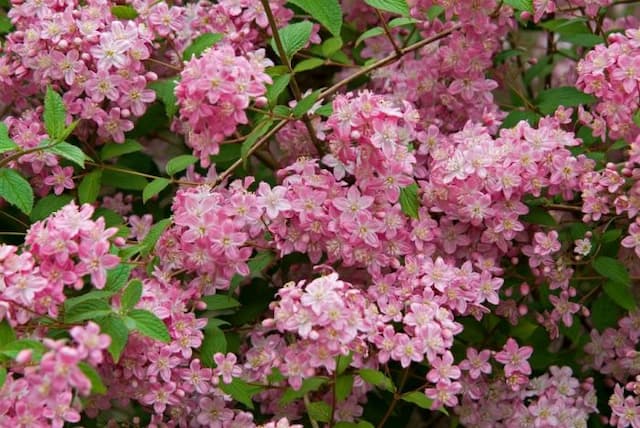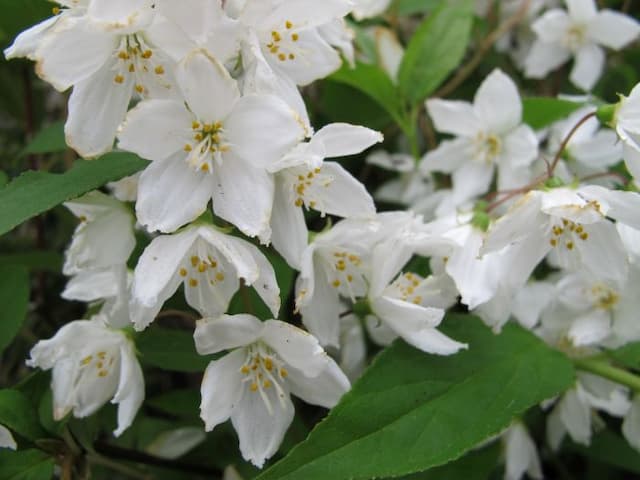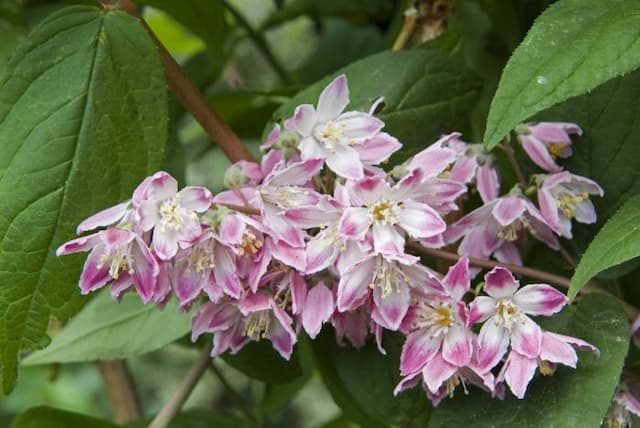Climbing Hydrangea Decumaria barbara

ABOUT
Decumaria barbara, commonly known as woodvamp, is a climbing plant that can attach to various surfaces. It has green leaves that are glossy, with a pale underside, forming an elegant foliage display. The leaves are oval-shaped with pointed tips and fine-toothed edges, creating a textured appearance. During the blooming period, woodvamp produces clusters of small, creamy white flowers that emit a subtle fragrance. The flowers are typically star-shaped. After the flowering season, woodvamp may develop small, inconspicuous fruits that are not commonly noticed. The overall appearance of this plant can vary, but its vine-like growth pattern and lush leaves provide a dense, leafy blanket over the surfaces it climbs.
About this plant
 Names
NamesFamily
Hydrangeaceae.
Synonyms
Climbing Hydrangea, Woodvamp, Decumaria.
Common names
Decumaria barbara var. barbara, Decumaria sinensis, Hydrangea decumaria.
 Toxicity
ToxicityTo humans
woodvamp is not commonly reported as being toxic to humans. However, as with many plants, individual reactions can vary and it is generally advisable to avoid ingesting parts of unknown plants due to potential risks or allergic reactions.
To pets
woodvamp is also not widely known to be toxic to pets. Nonetheless, it’s always prudent to prevent pets from consuming plants not intended for their consumption as they can cause gastric upset or other issues in some animals. If you suspect your pet has eaten a large amount of this plant and is showing signs of distress, consult a veterinarian.
 Characteristics
CharacteristicsLife cycle
Perennials
Foliage type
Deciduous
Color of leaves
Green
Flower color
White
Height
20-30 feet (6-9 meters)
Spread
20-30 feet (6-9 meters)
Plant type
Climber
Hardiness zones
7
Native area
Southeastern United States
Benefits
 General Benefits
General Benefits- Attracts Wildlife: The woodvamp (Decumaria barbara) provides nectar and habitat for various pollinators and birds.
- Erosion Control: The climbing and sprawling nature of woodvamp helps to stabilize soils, particularly on slopes, reducing soil erosion.
- Aesthetic Value: Woodvamp features attractive, glossy green foliage and clusters of white flowers that add beauty to gardens and landscapes.
- Shade Tolerance: This plant is capable of growing in shaded conditions where other plants may struggle to thrive.
- Low Maintenance: Woodvamp requires minimal care once established, making it a practical addition for low-maintenance gardens.
- Versatile Landscaping: It can be used for various landscaping purposes, including as a groundcover, to cover walls, or to climb structures like arbors.
- Natural Privacy Screen: When grown densely, woodvamp can act as a living privacy screen, obscuring unwanted views with its foliage.
 Medical Properties
Medical PropertiesThis plant is not used for medical purposes.
 Air-purifying Qualities
Air-purifying QualitiesThis plant is not specifically known for air purifying qualities.
 Other Uses
Other Uses- Decumaria barbara, commonly known as climbing hydrangea, can be used as a natural food source for certain wildlife like deer and rabbits, which may browse on its leaves and stems.
- The plant's strong, woody vines can be repurposed as natural ties or supports in the garden for staking other plants.
- The dense foliage of climbing hydrangea provides excellent cover and nesting opportunities for small birds and beneficial insects within a garden ecosystem.
- Vintage or rustic craft projects can utilize the dried vines of climbing hydrangea for creating wreaths and other decorative items.
- The climbing habit of this plant makes it ideal for use in privacy screens or living walls when grown against a fence or trellis.
- Climbing hydrangea can be trained to grow over unsightly structures, helping to integrate them into the landscape aesthetically.
- During autumn, the leaves of climbing hydrangea turn a vibrant yellow, which can be used in fall garden displays or as a natural dye source for fabrics.
- The exfoliating bark of mature climbing hydrangea vines adds a textural element to garden compositions, especially in winter gardens.
- As an educational tool, climbing hydrangea can demonstrate vertical gardening techniques and the concept of layering in landscape design to students and novice gardeners.
- Gardeners can employ climbing hydrangea as a means of soil stabilization on slopes or banks, where its root system helps to prevent erosion.
Interesting Facts
 Feng Shui
Feng ShuiThe plant Decumaria barbara, commonly known as Climbing Hydrangea, is not used in Feng Shui practice.
 Zodiac Sign Compitability
Zodiac Sign CompitabilityThe Climbing Hydrangea is not used in astrology practice.
 Plant Symbolism
Plant Symbolism- Endurance: Decumaria barbara, commonly known as climbing hydrangea, often grows in tough conditions on tree trunks and rock faces, symbolizing the ability to endure and thrive amidst challenges.
- Growth: As a climbing plant, it signifies growth and upward movement, representing personal or spiritual progress.
- Support: Climbing hydrangeas need structures to support their growth, which can symbolize the importance of community and relationships in one's life.
- Adaptation: This plant's versatility in growing in various environments speaks to adaptability and resilience in different situations.
 Water
WaterWoodvamp requires consistent moisture, and it should be watered when the top inch of soil feels dry to the touch. Typically, this equates to watering it every week, but this can vary depending on climate and weather conditions. During the growing season, you might water it with approximately one gallon per week, ensuring that the water penetrates deeply into the soil to encourage proper root growth. Adjust the amount of water during rainy periods or extreme heat, as the plant may need additional water to cope with drought stress.
 Light
LightFor Woodvamp, the best lighting conditions include partial to full shade. The ideal spot would be under the canopy of larger trees or on the north side of a building where it can receive filtered sunlight. Direct sun can scorch its leaves, so avoid placing it in areas where the midday sun is too intense.
 Temperature
TemperatureWoodvamp thrives in a temperature range between 60 to 80 degrees Fahrenheit. It can withstand occasional dips in temperature down to about 50 degrees Fahrenheit. However, it's not tolerant of frost, and temperatures below freezing can damage the plant. The ideal conditions for this climbing plant are typically found in USDA hardiness zones 7 through 9.
 Pruning
PruningWoodvamp should be pruned to control its growth and shape, as well as to remove any dead or damaged stems. Pruning is best done in the late winter or early spring before new growth begins. Prune the plant once a year, cutting back to healthy buds to encourage lush, full growth. This helps maintain an attractive form and prevents the plant from becoming too leggy or overgrown.
 Cleaning
CleaningAs needed
 Soil
SoilClimbing hydrangea prefers well-draining, rich soil with plenty of organic matter. The ideal soil pH should be slightly acidic to neutral, ranging from 5.6 to 7.0. A mixture containing peat, compost, and perlite or vermiculite is optimal for facilitating root growth and moisture retention.
 Repotting
RepottingClimbing hydrangea does not require frequent repotting and should generally be repotted once every 3 to 4 years. It prefers to be slightly root-bound, so overpotting can hinder its growth and flowering.
 Humidity & Misting
Humidity & MistingClimbing hydrangea thrives in moderate to high humidity levels but is quite adaptable. Aim for a relative humidity between 40% and 60% to maintain healthy growth without special requirements.
 Suitable locations
Suitable locationsIndoor
Ensure bright light and high humidity.
Outdoor
Plant in partial shade, moist, well-drained soil.
Hardiness zone
5-9 USDA.
 Life cycle
Life cycleThe life of the climbing hydrangea vine (Decumaria barbara) begins as a seed which germinates in moist, well-drained soil in a partially to fully shaded area, ideally attaching to a surface for climbing, such as a tree or rock face. The seedling then develops into a juvenile vine, which establishes a root system and begins to grow vertically or across surfaces with aerial rootlets. As the vine matures, it produces broad, glossy green leaves which are deciduous, falling off in the winter in colder climates. Once mature, the climbing hydrangea produces clusters of fragrant white flowers during late spring to early summer, attracting pollinators such as bees and butterflies. After pollination, these flowers develop into small, non-fleshy fruit which contain seeds, dispersing them to start a new generation. The plant can also spread vegetatively by layering, where stems come in contact with soil and root, thus expanding the parent plant's reach.
 Propogation
PropogationPropogation time
Spring to Summer
The most popular method of propagation for Decumaria barbara, commonly known as climbing hydrangea, is through semi-hardwood cuttings. This technique is usually performed in the late summer. To propagate, select a healthy semi-hardwood stem and cut a 4 to 6 inch (10 to 15 centimeters) segment, making sure it contains several leaf nodes. Remove the leaves from the lower half of the cutting and dip the cut end into a rooting hormone powder to encourage root growth. The cutting should then be planted in a moist potting mix and covered with a plastic bag or placed in a propagator to maintain humidity. The pot should be kept in indirect light until the cutting has rooted, which can usually be determined by gentle tugging to feel for resistance, indicating that roots have formed.





![Rose deutzia [Yuki Cherry Blossom]](/_next/image?url=https%3A%2F%2Fplants-admin.emdemapps.com%2Fimages%2Fplants%2F%2Fimages%2F604b6510a383a.png&w=640&q=75)
![Hydrangea [Hot Chocolate]](/_next/image?url=https%3A%2F%2Fplants-admin.emdemapps.com%2Fimages%2Fplants%2F%2Fimages%2F604b5a066e3bd.png&w=640&q=75)
![Hydrangea [Blackberry Pie]](/_next/image?url=https%3A%2F%2Fplants-admin.emdemapps.com%2Fimages%2Fplants%2F%2Fimages%2F604b56e2abc1d.png&w=640&q=75)

